
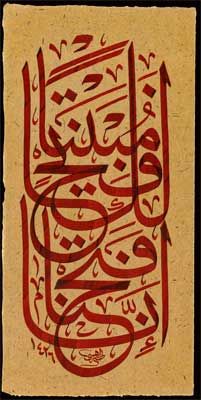
In conforming with Islamic philosophy, art by Moslem artists
concentrated on the spiritual representation of matter rather than its material
quality. This in turn gave birth to the stylised and abstract ornamentation of
the arabesque. Given the importance of the word of God as set in the holy
Qur'an, particular emphasis on the written word elevated Arabic Calligraphy
into peak artistic expression involoving divine and moral representations from
which it acquires its sublime reputation. Throughout the vast geography
of the Islamic world, it represents unity, beauty, and power. The aesthetic
principles of Arabic calligraphy are a reflection of the cultural values of the
Muslim world. In the words of Taha al-Hiti ''in the Oxford English
dictionary, Calligraphy is defined as 'the art of beautiful handwriting'.
Arabic Calligraphy however, is not quiet the same as it is a meticulous artform
based on precise proportion and measure, creating unique relationships between
letters, words, lines and paragraphs on the one hand and line weights, angles
and directions on the other.'' Arabic lettering has achieved a high level
of sophistication, and Arabic scripts can vary from flowing cursive styles like
Naskh and Thuluth to the angular
Kufi, achieved through the integration of
artistry and scholarship.
Al-Feth . Taha al-Hiti Indian ink on hemp 61x30cm 1426H/2005
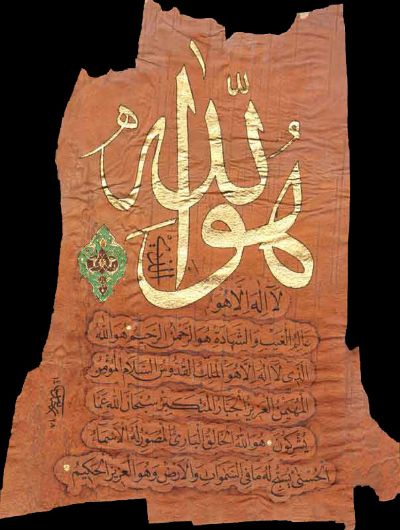 Rasheed Butt was born in Islamabad, Pakistan,
1943. Since 1961 he has totally devoted
himself to the study and practice of Islamic calligraphy. His work deals not only with the Holy Qur'an
but also with the body of sayings attributed to the Prophet Mohammed (PBUS), as
well as traditional prayers and pieces of Arabic and Persian poetry. His precise works of unique penmanship can be
admired at the Gate of Mecca in Saudi Arabia, Al-Furqan Foundation in London, The
Senate of Pakistan, the Shah Faisal Mosque in Islamabad and other places of importance. In 1989, Butt
received the 'Hightest Civil Award of the Government of Pakistan in Arts and
Culture' and more recently in 2000 was a jury member of the 5th
International Calligraphy Compitition organised by IRCICA, Istanbul, Turkey. Dr Annemarie Schimmel said of him 'At a time when many calligraphers
strive to create new and unusual forms, Butt has perfected the classical style
in an unsurpassable way. His Naskh is
masterly and the combination of Naskh and Kufic in his superb rendering of Surat al-Rahman is
unique'. Rasheed Butt lives and works in
Pakistan. Rasheed Butt was born in Islamabad, Pakistan,
1943. Since 1961 he has totally devoted
himself to the study and practice of Islamic calligraphy. His work deals not only with the Holy Qur'an
but also with the body of sayings attributed to the Prophet Mohammed (PBUS), as
well as traditional prayers and pieces of Arabic and Persian poetry. His precise works of unique penmanship can be
admired at the Gate of Mecca in Saudi Arabia, Al-Furqan Foundation in London, The
Senate of Pakistan, the Shah Faisal Mosque in Islamabad and other places of importance. In 1989, Butt
received the 'Hightest Civil Award of the Government of Pakistan in Arts and
Culture' and more recently in 2000 was a jury member of the 5th
International Calligraphy Compitition organised by IRCICA, Istanbul, Turkey. Dr Annemarie Schimmel said of him 'At a time when many calligraphers
strive to create new and unusual forms, Butt has perfected the classical style
in an unsurpassable way. His Naskh is
masterly and the combination of Naskh and Kufic in his superb rendering of Surat al-Rahman is
unique'. Rasheed Butt lives and works in
Pakistan.
Huwa Allah . Rasheed Butt . Ink and gold on Bhorj Pater 28x21cm 1428h/2007 RB010

 About his work, Rasheed Butt reveals 'I am overwhelmed with the charm and captivating
language of the holy Quran and the Sunnah. It gives me much pride to know that my hand is an instrument in creating delightful
expressions of this Divine message. With this, I earnestly desire that viewers may begin
to understand the true essence of this Great Message. My work in Calligraphy is my fate and destiny, to which I have dedicated my life In many of my artworks I use Bhorj Pater; a rare kind of natural raw paper, not used for more than 400 years due to difficulties in obtaining it
as it can only be found at 1500 meters above sea level near the Himalayan Mountains. I have revived its usage for the unique qualities it posesses particularly rendering it flexible in rectifying
mistakes. I also use decorative features
from diverse civilizations which have been unified through Islam. This is not only an aesthetic attribute but an
essential part of calligraphy which brings the work to completion. I believe that the art of Arabic Calligraphy has decreased over
time. In the past, State patronage of
Calligraphers and Calligraphy elevated it to the highest point of artistic
expression. In recent
years, there has been a resurgence of interest in Islam. What better way to enter it than through art! About his work, Rasheed Butt reveals 'I am overwhelmed with the charm and captivating
language of the holy Quran and the Sunnah. It gives me much pride to know that my hand is an instrument in creating delightful
expressions of this Divine message. With this, I earnestly desire that viewers may begin
to understand the true essence of this Great Message. My work in Calligraphy is my fate and destiny, to which I have dedicated my life In many of my artworks I use Bhorj Pater; a rare kind of natural raw paper, not used for more than 400 years due to difficulties in obtaining it
as it can only be found at 1500 meters above sea level near the Himalayan Mountains. I have revived its usage for the unique qualities it posesses particularly rendering it flexible in rectifying
mistakes. I also use decorative features
from diverse civilizations which have been unified through Islam. This is not only an aesthetic attribute but an
essential part of calligraphy which brings the work to completion. I believe that the art of Arabic Calligraphy has decreased over
time. In the past, State patronage of
Calligraphers and Calligraphy elevated it to the highest point of artistic
expression. In recent
years, there has been a resurgence of interest in Islam. What better way to enter it than through art!

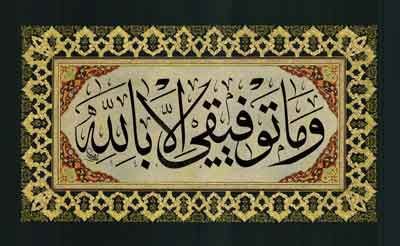 Wa ma Tawfeeqi illa billah Wa ma Tawfeeqi illa billah
Arabic ink on special paper
30x54cm
53x77cm framed
1426H
2005
TH 001
Taha Al-Hiti is an architect by profession.
From a very early age however he was enchanted with writing, in particular the way Arabic
letters, words and lines joined to form calligraphy. Touched by the teachings of master
calligrapher Abbas Shakir Joody al-Baghdadi, he soon learned to distinguish between
the different styles e.g. Turkish, Baghdadi and Egyptian and even
learnt to 'guess the calligrapher' who was behind an exquisite pieces of calligraphy! "It was from calligraphy, I fell in love with
Architecture; Calligraphy in its larger scale is linked to Architecture, both being
essentially based on proportion and measure."
 Am'men Yujeebu al-Muth'tar'ra itha Da'ah wa Yekshif al-Sou Am'men Yujeebu al-Muth'tar'ra itha Da'ah wa Yekshif al-Sou
Arabic ink on special paper
1426H/2005
26x93cm TH 003

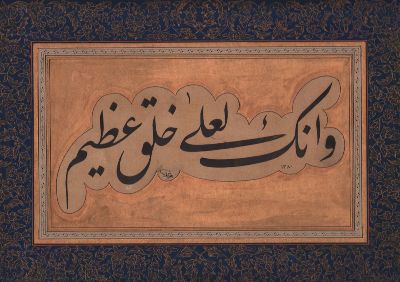
Wa Inneka le'ala Khuluqin Adheem
Ink on paper
20x30cm
HKh006

 Surat al-Hassad Surat al-Hassad
Ink on special paper
18x35cm
2002
GQ008
Khursheed Alam known as Gohar Qalam was born in the Khushab district, Pakistan, 1956. His early education took place in the city of Sargodha under Ustad Ismail Dehlevi. Thereafter he studied under the late Hafiz Yousuf Sadidi who was one of the great masters of calligraphy of the Indian subcontinent. The title of Gohar Qalam was bestowed on him by the late Nafees Qalam, another master of calligraphy and by Professor Ghulam Nizamuddin of the University of Punjab. His major works include a copy of the Holy Quran placed in the main State Mosque known as the Faisal Mosque in Islamabad and includes 406 styles of calligraphy. The entire manuscript weighing 1600 kilograms is divided into 30 parts and placed in separate show cases. His calligraphy adorns some of the most important public buildings in the Islamic Republic of Pakistan such as the extension of the Mosque and tomb complex of the premier Saint of South Asia who is buried in Lahore and known as the Data Ganj Baksh shrine. The Lahore international airport also features his work in its main departure lounge and rendered in ceramics.

Gohar Qalam
Allah Khairun Hafidhan wa Huwa Arham al-Rahimeen
Ink on Bhuj Putter
21x32cm
2002 GQ009
 Wa Huwa ala Kul Shai'n Qadeer Wa Huwa ala Kul Shai'n Qadeer
Ink on Buhj Putter
32x23cm
GQ001
Gohar Qalam was awarded a special award in 1989 by the
then Prime Minister of Pakistan and in 1992 he was the recipient of
Pride of Performance Award by the President of Pakistan. In 2005 he was
given a special award by the Japanese foreign minister at the
International Calligraphy exhibition held at Tokyo's Metropolitan
University. On numerous occasions the Government of Pakistan have
presented his works as State gifts to visiting heads of States. Apart
from numerous public collections in Pakistan, Gohar Qalam is the
only Pakistani to have been collected by both the Ashmolean Museum in
Oxford and the British Museum in London where numerous examples of his
work form part of their permanent collections. He is a
master of Lahori Nastaliq and also of the six other major scripts as
have been practised in South Asia. The present work is either on tree
bark known as Bhuj Putter or alternatively on paper specially prepared
in the Mughal techniques known as Wasli under the supervision of
Professor Bashir Ahmed the head of the fine arts department at the
National College of Arts. The style of calligraphy used is known as
Hindustani Thuluth and this is different from the Ottoman school in
that it is lighter. Other examples are Ghubari Naskh and a rare style
of calligraphy known as Mufajjar. Gohar Qalam has been
teaching for a number of years as the Professor of calligraphy at the
National College of Arts formerly known as the Mayo School of Arts
founded in the 19th century by Lockwood Kipling, the father of Rudyard
Kipling.


Mohammed Rassoul Allah
Ink on paper
circa 1988
KZ 001

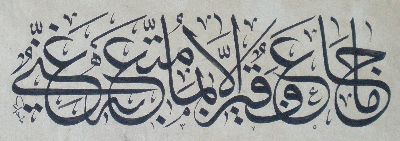
Ma Ja'a Faqeer
Ink on paper
15x37cm
1375h
MZ201
|


